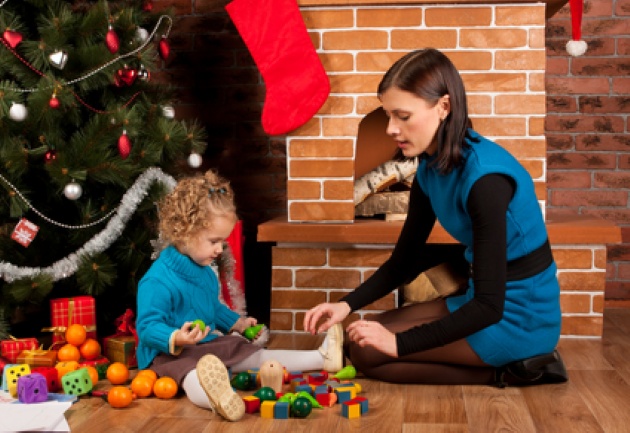With the holidays just around the corner, parents are scrambling to find the perfect gift for their little ones. As a Speech-Language Pathologist, I am often asked, “What can I buy that is fun, educational, and will also support my child’s language development?” The answer might surprise you.
You and your child can enjoy plenty of great games, toys, and books without purchasing costly, specialized 'educational' materials. It is important to keep in mind that the focus should not be placed on the type of materials you use, but rather on the way you use them. It's all about presenting fun and creative activities to your child. An easy way to start is by familiarizing yourself with the way that a game is meant to be played, by reading through the instructions. Afterwards, feel free to get creative and modify the game however you like. Games can be played in many ways. For example, you can do so much more than just kick a ball - you can roll it, spin it, bounce it, hide it, match it, decorate it, and so on. The same is true of any activity.
For all of you wonderful holiday shoppers, the suggestions below might help you on your way. All of these items can be found in any toy store or department store with a toy section and even in some bigger pharmacies and/or dollar stores.
If your child is non-verbal or an early language learner, then read the list below with suggestions for toys, games, books, and ideas for activities.
Toys;
- Toy kitchen set (spoons, pots and pans, fruits, vegetables, dairy, bowls, cups). You can actually find fruits and vegetables that can be “cut in half” as they come in two pieces and attach together with Velcro.
- Miniature farm animals and/or zoo animals
- Tea party set
- Mechanic / tool sets
- Grocery set (foods, cash register, and fake money)
- Doctor sets (stethoscope, bandages)
Any of these toy sets can be used to practice vocabulary by having your child name the objects or having your child find the objects you name. Labeling the actions like 'cutting', 'washing', and 'fixing' is an easy way of working on your child’s expression skills. Work on comprehension skills by giving your child instructions like, 'put the fruit in the bowl', 'find all the spoons', 'fix daddy’s table with the hammer', 'give everybody a cup', and 'put a band-aid on the doll'. Let your child be creative as well and let different scenarios play out. Follow along in your child’s play and introduce new scenarios if your child repeats the same routine every time. Remember, you don't have to drill your child or force new scenarios - it's about having fun together!
Games;
- Simple Bingo and/or matching games (color matching, match the animals, match the characters). Make sure to use clear and simple pictures without too much detail.
- Simple board games like Snail Race or Snakes and Ladders can add some fun, too.
- Magnet boards with different themes (at school, at the park, at home, on the street)Puzzles
- The game Cariboo is a more advanced matching game, but it can be used for younger children as well.
- The game Twister can help your child follow instructions and give instructions.
Any of these games can be simplified if needed, as your child may not yet have developed the attention span to follow a lengthy game. Matching games don’t have to be competitive. They can just be a fun cooperative game where you work together to find all of the matching cards face-up on the table. You can stimulate language by talking about the pictures and asking your child which picture he/she likes best or which picture he/she wants to find next. Matching games can also be played in a hide-and-seek format if your child would rather move around than sit for long periods of time. Hide one set of pictures throughout the room and leave the matching set on the table. Have your child find the hidden pictures and tell you what they were and where he/she found each picture using words like ‘on’, ‘under’, and ‘behind’.
Books;
You can use any kind of book your child is interested in, as long as you adjust the story to your child’s level. An early language learner might not be able to follow the text written but can still enjoy the pictures and the story. Become familiar with new books before you read them to your child so that you can simplify the text. Use shorter sentences and simple vocabulary while still following the general storyline. Talk more about the pictures and encourage your child to talk about the pictures as well. Make sure not to get stuck on labeling objects, instead focus the discussion on the actions (e.g. 'The bird is flying', ' The princess is sleeping').
If your child is a more advanced language learner, take a look at the following list of suggestions for games, books, and activity ideas.
Games;
- Guess Who and Guess Where; these are great games for working on asking questions about characters and location (e.g. Does your person have black hair? Is your mommy in the living room?). It will also help your child to practice reasoning and drawing inferences.
- Headbanz; this is another fun game that focuses on asking questions in order to identify a secret object and/or character (e.g. Do I fly? Can you eat me?).
- Monopoly (junior edition). You can discuss many different topics while playing the game (e.g. What does the banker do? Who has the most money? Who is going to own a full block soon?). You can also work on some math concepts. Make a game like this interactive.
- Cranium (junior or family edition). This is a very interactive game that you can use to build in a lot of language and encourage your child to answer questions in a full sentence.
- Apples to apples (junior edition). This game requires your child to match nouns to adjectives (e.g. orange to juicy). To train language even more, you can ask your child why he/she thinks each noun-adjective pair goes together. Encourage your child to explain and to use full sentences.
While playing board games, you can talk about the pictures on the game board and ask your child to predict what will happen next or what will happen if you land on a particular space. Build in language wherever you can by talking about the colors and the actions (rolling the dice, taking turns, and counting the steps). Challenge your child to reason, think and predict. If your child has difficulties with formulating grammatically correct sentences, repeat your child’s sentence but correct it grammatically, so that your child can hear the correct model. You can emphasize specific parts of the sentence (e.g. Your child might say, “I am something to eat?” You can model correct grammar by saying, “Oh, you are asking, “AM I something to eat?” Don’t force your child to repeat your version; the goal is to offer your child the correct model so he/she can hear it). If you’re looking for an arts and crafts activity for the holiday season, you can get creative by making your own board game. Make your own Snakes and Ladders board game (draw, cut and paste construction paper onto cardboard). Make your own family matching game; print two sets of family photographs or you can use different pictures of the same person.
Books;
Some children who struggle with language might not always enjoy being read to or reading by themselves. Entice your child with books that have less of a storyline, but offer facts instead, such as fun-facts about animals (e.g. Did you know that a snail can sleep for three years?). It might be easier for your child to listen to shorter blocks of information than to a whole story where it is crucial to process larger pieces of verbal information.
The following are fun holiday-themed activities for children of all ages
Involve your child in baking and cooking activities. Buy a little apron and decorate it together by writing your child’s name on it. Most kids love to be helpers in the kitchen by stirring the batter and decorating cookies. There are wonderful children’s cookbooks out there to help you get started. You can also create a little baking kit for your child; include an apron, cookie cutters, bowl, wooden spoon, and baking tray. Discuss the different steps for making dough; for example, which ingredients are needed to make the dough, what goes in the bowl first, what comes next, and so on. Fill up little tins with your child’s creations and you’ll also have some very special holiday gifts. Encourage your older children to retell the sequence of actions and to do so in full sentences. Again, provide the correct language model if needed.
Finally, you may want to visit www.superduperinc.com for more specialized and affordable materials. You can also find more educational materials at www.kizclub.com and www.starfall.com.
Have fun and happy holidays!




 BY:
BY: 

Tweet
Share